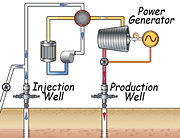- Number 344 |
- August 22, 2011
A plan to produce electricity and trap carbon at the same time

CO2-store-power.
A team lead by scientists at DOE’s Lawrence Berkeley National Laboratory (Berkeley Lab) is field-testing a scheme to use geothermally heated CO2 to make electricity and permanently store the CO2 underground at the same time.
Berkeley Lab scientists and others have long theorized that CO2 in the supercritical state – with properties between a liquid and a gas – can be used instead of water to tap into geothermal energy, and in fact would be better than water at mining heat from below. But no one has actually tried it – until now.
The hope is to offset the cost of geological carbon storage, which involves first capturing CO2 from sources like coal, gas, and oil-fired power plants, then pumping it deep underground for permanent sequestration. While this could keep the fossil-fuel plants from releasing greenhouse gases into the atmosphere, it’s an expensive proposition.
“Carbon storage takes a lot of power,” says Barry Freifeld of Berkeley Lab’s Earth Sciences Division, who is directing the new test. “We may be able to bring down its costs by generating electricity on the side.”
The first tests of the novel system will be conducted at the Southeast Regional Carbon Sequestration Partnership in Cranfield, Mississippi, site of a DOE-funded CO2 injection project since 2009. CO2 will be injected three kilometers underground into a hot sedimentary layer where, at 125˚ Celsius, it will enter the supercritical state.
The plan is to pull the supercritical CO2 back to the surface and feed it through a turbine designed to handle CO2 that’s “dirty” from underground hydrocarbons and water. After generating electricity, the CO2 loops back underground and repeats the whole cycle – again and again. On each pass some of the CO2 is permanently trapped in the sediment, while more is continuously added to keep the turbines spinning.
In conventional geothermal energy projects, five to ten percent of the water injected is lost in the hot rock formations. The need to add more can impact municipal water sources with little to spare.
“But we actually want some of the CO2 to become trapped,” says Freifeld. “Our approach relies on this gradual loss as a way to store a power plant’s CO2 underground rather than emitting it into the atmosphere. Our planned demonstration is the first attempt at proving that we can simultaneously mitigate greenhouse gas induced climate change and generate clean baseload power using geothermal energy.”[Dan Krotz, 510.486.4019,
dakrotz@lbl.gov]
